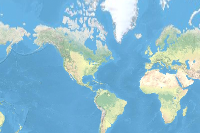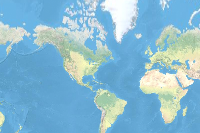- 🔬 Data Science
- 🥠 Deep Learning and image translation
Introduction
In this notebook, we will focus on using Pix2Pix [1], which is one of the famous and sucessful deep learning models used for paired image-to-image translation. In geospatial sciences, this approach could help in wide range of applications traditionally not possible, where we may want to go from one domain of images to another.
The aim of this notebook is to make use of arcgis.learn Pix2Pix model to translate or convert the gray-scale DSM to a RGB imagery. For more details about model and its working refer How Pix2Pix works ? in guide section.
Necessary imports
import os, zipfile
from pathlib import Path
from os import listdir
from os.path import isfile, join
from arcgis import GIS
from arcgis.learn import Pix2Pix, prepare_dataConnect to your GIS
ent_gis = GIS(profile="your_enterprise_profile")Export image domain data
For this usecase, we have a high-resolution NAIP airborne imagery in the form of IR-G-B tiles and lidar data converted into DSM, collected over St. George, state of utah by state of utah and partners [5] with same spatial resolution of 0.5 m. We will export that using “Export_Tiles” metadata format available in the Export Training Data For Deep Learning tool. This tool is available in ArcGIS Pro as well as ArcGIS Image Server. The various inputs required by the tool, are described below.
Input Raster: DSMAdditional Input Raster: NAIP airborne imageryTile Size X & Tile Size Y: 256Stride X & Stride Y: 128Meta Data Format: 'Export_Tiles' as we are training aPix2Pixmodel.Environments: Set optimumCell Size,Processing Extent.
Raster's used for exporting the training dataset are provided below
naip_domain_b_raster = ent_gis.content.get('319726e4cb4f4d69b471d65cc461b0a8')
naip_domain_b_rasterdsm_domain_a_raster = ent_gis.content.get('d8f21b09b7774a8f91f3152077eceffd')
dsm_domain_a_raster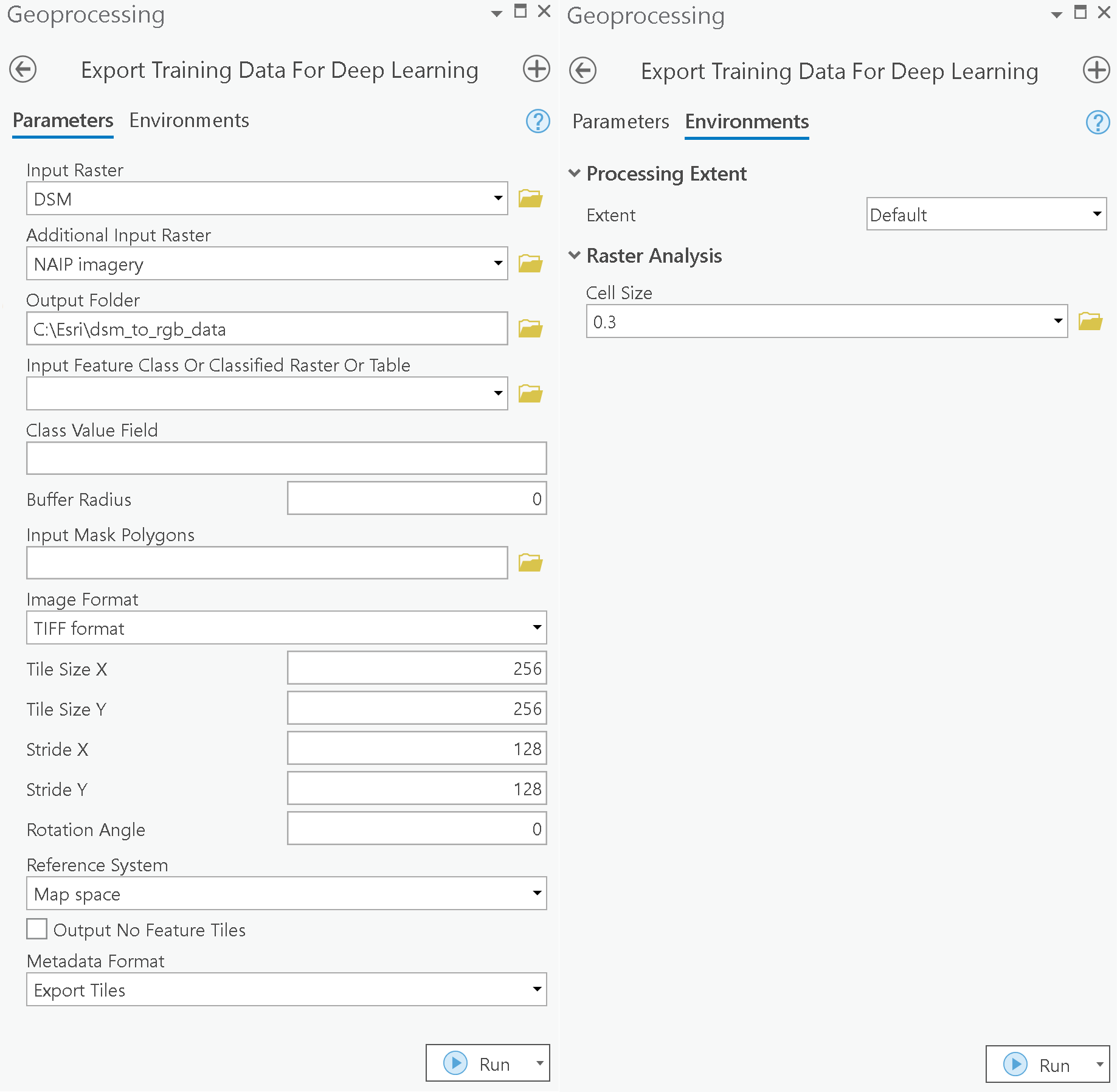
Inside the exported data folder, 'Images' and 'Images2' folders contain all the image tiles from two domains exported from DSM and drone imagery respectively. Now we are ready to train the Pix2Pix model.
Model training
Alternatively, we have provided a subset of training data containing a few samples that follows the same directory structure mentioned above and also provided the rasters used for exporting the training dataset. You can use the data directly to run the experiments.
training_data = ent_gis.content.get('2a3dad36569b48ed99858e8579611a80')
training_datafilepath = training_data.download(file_name=training_data.name)#Extract the data from the zipped image collection
with zipfile.ZipFile(filepath, 'r') as zip_ref:
zip_ref.extractall(Path(filepath).parent)Prepare data
output_path = Path(os.path.join(os.path.splitext(filepath)[0]))data = prepare_data(output_path, dataset_type="Pix2Pix", batch_size=5)Visualize a few samples from your training data
To get a sense of what the training data looks like, arcgis.learn.show_batch() method randomly picks a few training chips and visualize them. On the left are some DSM's (digital surface model) with the corresponding RGB imageries of various locations on the right.
data.show_batch()
Load Pix2Pix model architecture
model = Pix2Pix(data)Tuning for optimal learning rate
Learning rate is one of the most important hyperparameters in model training. ArcGIS API for Python provides a learning rate finder that automatically chooses the optimal learning rate for you.
lr = model.lr_find()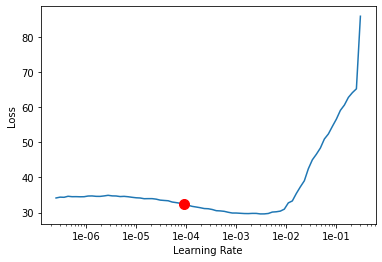
2.5118864315095795e-05
Fit the model
The model is trained for around a few epochs with the suggested learning rate.
model.fit(30, lr)| epoch | train_loss | valid_loss | gen_loss | l1_loss | D_loss | time |
|---|---|---|---|---|---|---|
| 0 | 13.203547 | 13.980255 | 0.576110 | 0.126274 | 0.412447 | 01:01 |
| 1 | 12.675353 | 13.891787 | 0.573363 | 0.121020 | 0.411131 | 01:02 |
| 2 | 12.830377 | 13.652339 | 0.577334 | 0.122530 | 0.410224 | 01:00 |
| 3 | 12.826028 | 13.478950 | 0.578673 | 0.122474 | 0.410028 | 01:01 |
| 4 | 12.830496 | 13.464501 | 0.579446 | 0.122510 | 0.407034 | 01:01 |
| 5 | 12.978190 | 13.808777 | 0.581329 | 0.123969 | 0.405155 | 01:01 |
| 6 | 12.933887 | 14.188525 | 0.579817 | 0.123541 | 0.402280 | 01:01 |
| 7 | 12.660383 | 13.273459 | 0.583129 | 0.120773 | 0.398041 | 01:01 |
| 8 | 12.493378 | 13.234705 | 0.584513 | 0.119089 | 0.395928 | 01:02 |
| 9 | 12.704373 | 14.314936 | 0.583671 | 0.121207 | 0.393755 | 01:01 |
| 10 | 12.283652 | 12.872752 | 0.586115 | 0.116975 | 0.391496 | 01:01 |
| 11 | 12.008025 | 12.989032 | 0.585851 | 0.114222 | 0.386542 | 01:02 |
| 12 | 11.848214 | 12.356230 | 0.586706 | 0.112615 | 0.385120 | 01:01 |
| 13 | 11.648248 | 12.387824 | 0.586294 | 0.110620 | 0.383345 | 01:01 |
| 14 | 11.220642 | 12.051290 | 0.586354 | 0.106343 | 0.380747 | 01:01 |
| 15 | 11.065363 | 11.816018 | 0.587154 | 0.104782 | 0.379417 | 01:01 |
| 16 | 11.107099 | 11.579307 | 0.587886 | 0.105192 | 0.377144 | 01:02 |
| 17 | 10.680603 | 11.504006 | 0.587307 | 0.100933 | 0.375779 | 01:03 |
| 18 | 10.604408 | 11.234290 | 0.587380 | 0.100170 | 0.373917 | 01:03 |
| 19 | 10.459021 | 11.162776 | 0.586817 | 0.098722 | 0.372892 | 01:05 |
| 20 | 10.251445 | 10.944400 | 0.587671 | 0.096638 | 0.371933 | 01:02 |
| 21 | 10.173382 | 10.966841 | 0.587322 | 0.095861 | 0.371821 | 01:01 |
| 22 | 9.945634 | 10.783834 | 0.587247 | 0.093584 | 0.371387 | 01:01 |
| 23 | 9.681182 | 10.716444 | 0.587864 | 0.090933 | 0.369668 | 01:01 |
| 24 | 9.872039 | 10.600616 | 0.588303 | 0.092837 | 0.369563 | 01:00 |
| 25 | 9.786720 | 10.603912 | 0.588364 | 0.091984 | 0.369715 | 01:02 |
| 26 | 9.680658 | 10.506352 | 0.587878 | 0.090928 | 0.369863 | 01:02 |
| 27 | 9.386904 | 10.502596 | 0.587328 | 0.087996 | 0.368502 | 01:01 |
| 28 | 9.835923 | 10.505837 | 0.588324 | 0.092476 | 0.369696 | 01:01 |
| 29 | 9.630071 | 10.498654 | 0.586929 | 0.090431 | 0.368856 | 01:00 |
Here, with 30 epochs, we can see reasonable results — both training and validation losses have gone down considerably, indicating that the model is learning to translate between domain of imageries.
Save the model
We will save the model which we trained as a 'Deep Learning Package' ('.dlpk' format). Deep Learning package is the standard format used to deploy deep learning models on the ArcGIS platform.
We will use the save() method to save the trained model. By default, it will be saved to the 'models' sub-folder within our training data folder.
model.save("pix2pix_model_e30", publish =True)Visualize results in validation set
It is a good practice to see results of the model viz-a-viz ground truth. The code below picks random samples and shows us ground truth and model predictions, side by side. This enables us to preview the results of the model within the notebook.
model.show_results()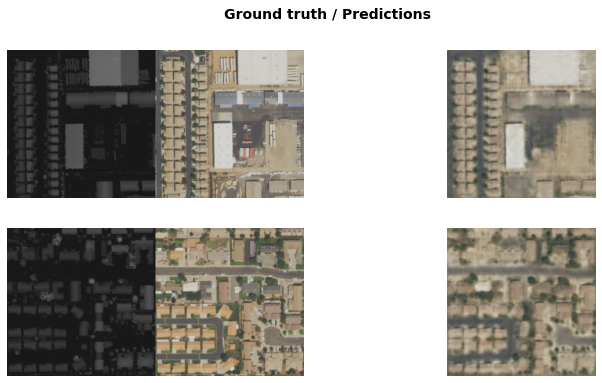
Compute evaluation metrics
The Frechet Inception Distance score, or FID for short, is a metric that calculates the distance between feature vectors calculated for real and generated images. Lower scores indicate the two groups of images are more similar, or have more similar statistics, with a perfect score being 0.0 indicating that the two groups of images are identical.
model.compute_metrics()263.63128885232044
Model inferencing
Inference on a single imagery chip
We can translate DSM to RGB imagery with the help of predict() method.
Using predict function, we can apply the trained model on the image chip kept for validation, which we want to translate.
img_path: path to the image file.
valid_data = ent_gis.content.get('f682b16bcc6d40419a775ea2cad8f861')
valid_datafilepath2 = valid_data.download(file_name=valid_data.name)# Visualize the image chip used for inferencing
from fastai.vision import open_image
open_image(filepath2)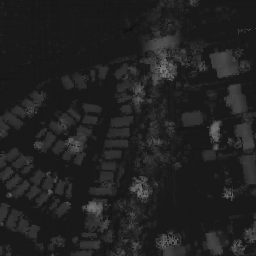
#Inference single imagery chip
model.predict(filepath2)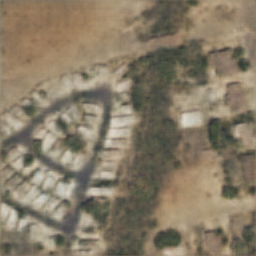
Generate raster using classify pixels using deep learning tool
After we trained the Pix2Pix model and saved the weights for translating image and we could use the classify pixels using deep learning tool avialable in both ArcGIS pro and ArcGIS Enterprise for inferencing at scale.
test_data = ent_gis.content.get('ee2729b5b0f845d291a9866696cdd33a')
test_data
out_classified_raster = arcpy.ia.ClassifyPixelsUsingDeepLearning("Imagery", r"C:\path\to\model.emd", "padding 64;batch_size 2"); out_classified_raster.save(r"C:\sample\sample.gdb\predicted_img2dsm")
Results visualization
The RGB output raster is generated using ArcGIS Pro. The output raster is published on the portal for visualization.
inferenced_results = ent_gis.content.get('4c0a3d149ece42559b06d82fdb204898')
inferenced_resultsCreate map widgets
Two map widgets are created showing DSM and Inferenced RGB raster.
map1 = ent_gis.map('Washington Fields')
map1.zoom = 13
map1.content.add(test_data)
map2 = ent_gis.map('Washington Fields')
map2.zoom = 13
map2.content.add(inferenced_results)Synchronize web maps
The maps are synchronized with each other using MapView.sync_navigation functionality. It helps in comparing the inferenced results with the DSM. Detailed description about advanced map widget options can be referred here.
map2.sync_navigation(map1)Set the map layout
from ipywidgets import HBox, VBox, Label, LayoutHbox and Vbox were used to set the layout of map widgets.
hbox_layout = Layout()
hbox_layout.justify_content = 'space-around'
hb1=HBox([Label('DSM'),Label('RGB results')])
hb1.layout=hbox_layoutResults
The predictions are provided as a map for better visualization.
VBox([hb1,HBox([map1,map2])])
map2.zoom_to_layer(inferenced_results)Conclusion
In this notebook, we demonstrated how to use Pix2Pix model using ArcGIS API for Python in order to translate imagery of one domain to the another domain.
References
- [1]. Isola, Phillip, Jun-Yan Zhu, Tinghui Zhou, and Alexei A. Efros. "Image-to-image translation with conditional adversarial networks." In Proceedings of the IEEE conference on computer vision and pattern recognition, pp. 1125-1134. 2017.
- [2]. Goodfellow, Ian, Jean Pouget-Abadie, Mehdi Mirza, Bing Xu, David Warde-Farley, Sherjil Ozair, Aaron Courville, and Yoshua Bengio. "Generative adversarial nets." In Advances in neural information processing systems, pp. 2672-2680. 2014.
- [3]. https://stephan-osterburg.gitbook.io/coding/coding/ml-dl/tensorfow/chapter-4-conditional-generative-adversarial-network/acgan-architectural-design
- [4]. Kang, Yuhao, Song Gao, and Robert E. Roth. "Transferring multiscale map styles using generative adversarial networks." International Journal of Cartography 5, no. 2-3 (2019): 115-141.
- [5]. State of Utah and Partners, 2019, Regional Utah high-resolution lidar data 2015 - 2017: Collected by Quantum Spatial, Inc., Digital Mapping, Inc., and Aero-Graphics, Inc. and distributed by OpenTopography, https://doi.org/10.5069/G9RV0KSQ. Accessed: 2020-12-08
